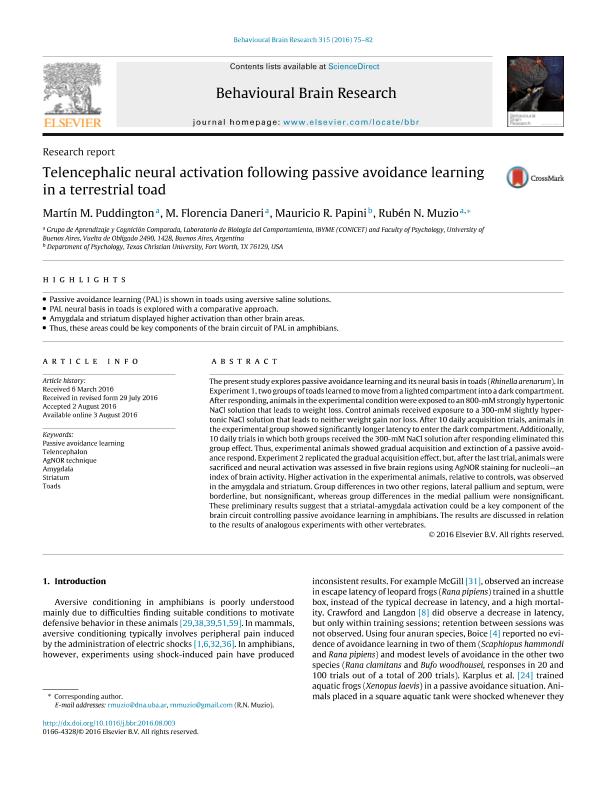Artículo
Telencephalic neural activation following passive avoidance learning in a terrestrial toad
Fecha de publicación:
12/2016
Editorial:
Elsevier Science
Revista:
Behavioural Brain Research
ISSN:
0166-4328
e-ISSN:
0166-4328
Idioma:
Inglés
Tipo de recurso:
Artículo publicado
Clasificación temática:
Resumen
The present study explores passive avoidance learning and its neural basis in toads (Rhinella arenarum). In Experiment 1, two groups of toads learned to move from a lighted compartment into a dark compartment. After responding, animals in the experimental condition were exposed to an 800-mM strongly hypertonic NaCl solution that leads to weight loss. Control animals received exposure to a 300-mM slightly hypertonic NaCl solution that leads to neither weight gain nor loss. After 10 daily acquisition trials, animals in the experimental group showed significantly longer latency to enter the dark compartment. Additionally, 10 daily trials in which both groups received the 300-mM NaCl solution after responding eliminated this group effect. Thus, experimental animals showed gradual acquisition and extinction of a passive avoidance respond. Experiment 2 replicated the gradual acquisition effect, but, after the last trial, animals were sacrificed and neural activation was assessed in five brain regions using AgNOR staining for nucleoli?an index of brain activity. Higher activation in the experimental animals, relative to controls, was observed in the amygdala and striatum. Group differences in two other regions, lateral pallium and septum, were borderline, but nonsignificant, whereas group differences in the medial pallium were nonsignificant.These preliminary results suggest that a striatal-amygdala activation could be a key component of the brain circuit controlling passive avoidance learning in amphibians. The results are discussed in relationto the results of analogous experiments with other vertebrates.
Archivos asociados
Licencia
Identificadores
Colecciones
Articulos(IBYME)
Articulos de INST.DE BIOLOGIA Y MEDICINA EXPERIMENTAL (I)
Articulos de INST.DE BIOLOGIA Y MEDICINA EXPERIMENTAL (I)
Citación
Puddington, Martin Miguel; Daneri, María Florencia; Papini, Mauricio Roberto; Muzio, Ruben Nestor; Telencephalic neural activation following passive avoidance learning in a terrestrial toad; Elsevier Science; Behavioural Brain Research; 315; 12-2016; 75-82
Compartir
Altmétricas




